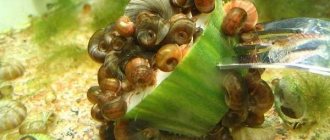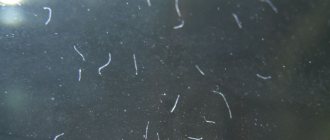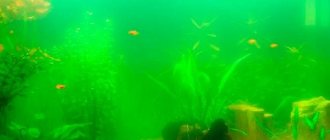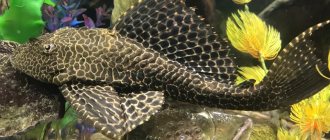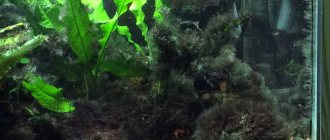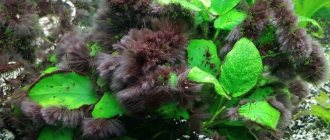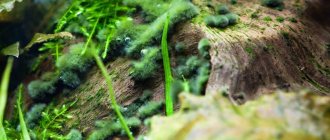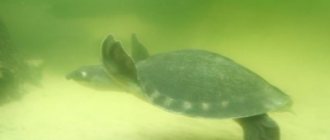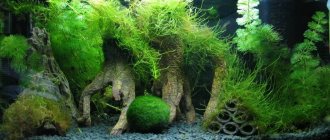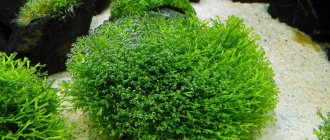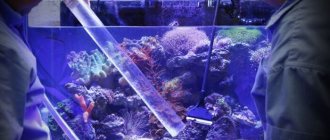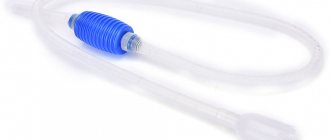In most cases, algae causes a negative reaction in aquarists. They look untidy and spoil the appearance of the composition. At the same time, not all plants are an integral part of living nature. They live in the surface waters of the planet. It is from them that the existence of most aquatic ecosystems begins. However, an aquarium is a biocenosis and not a natural body of water. It is supported artificially. Filamentous algae, like all other species, settle here independently. These are lower algae, and they do more harm than good.
Description and types of filamentous algae in the aquarium, how to recognize
Filament is represented by a wide variety of species. Each of them must be dealt with individually. If it is possible to determine the specific type of parasite, this will allow us to quickly move on to its immediate elimination.
The main algae are:
- Edogonium. A classic example of filamentous algae. Externally, the shape resembles a fluffy green ball. The appearance of this plant indicates a lack of useful elements in the aquarium.
- Cladophora. The parasite looks like long threads. With an excess amount of microelements and impaired water circulation, it develops rapidly and rapidly.
- Spirogyra. Floating algae get along well with other plants and are able to adapt to any living conditions. They quickly fill the free space, the plant is slippery to the touch, the leaves are easily rubbed with your hands.
- Rhizoclonium. Looks like a cladophora. If its spores are present in the aquarium, it quickly makes itself felt, usually after the first start of the aquarium. At the same time, there is no particular threat emanating from him.
If filament appears in the aquarium, this indicates improper care of it. Even if it looks beautiful, you should get rid of it quickly. The algae got its name because it is formed by long and small threads, presented in large quantities. They are usually green in color. It is worth distinguishing them from brown and black algae, which appear for the same reasons.
How to distinguish them:
- plants consist of thin green threads;
- their texture is slippery and soft;
- If you take such a plant out of the water, it will become deformed.
Fighting methods
Filamentous algae will certainly appear in a reservoir if there is an excess content of water-soluble nitrogen and phosphorus compounds. Therefore, first of all you need to pay attention to the operation of the filter and lighting. Blue light, which favors the growth of filament, must be eliminated and replaced with soft light.
The accumulation of ammonia compounds occurs both when the filter is clogged and when there are too many fish and not enough plants. Floating plants and those that grow quickly (hygrophiles, Vallisneria) inhibit filamentous algae, depriving them of nutrition. The concentration of iron in the aquarium is of great importance. It should not exceed the permissible dose of 0.2 mg/l.
Removing algae from the aquarium by hand, for example when infesting with Spirogyra, is almost the only method of control. It is very important to clean the plants from threads and wash them, and add CO2 to the aquarium only during the daytime. In addition to all cleaning activities, many recommend darkening the aquarium for three days.
In some cases, the use of algaecides, such as Sidex, containing glutaraldehyde, is very effective. Hydrogen peroxide in an amount of 6 to 10 mg/l and filamentous solution are also incompatible.
Biological methods of destroying parasitic algae should not be neglected. Those who eat filament are catfish, gastromyzons, viviparous fish, platies and mollies, as well as carp, jordanella, and Siamese epalceorhynchos.
Reasons for the appearance of filament in an aquarium
There are many varieties of filamentous algae. Almost all aquarists have to deal with this phenomenon.
The main reasons for the appearance of the parasite are:
- Excessive lighting. If the aquarium is exposed to sunlight or regularly lit by artificial lamps, the likelihood of algae growth increases.
- Insufficient aeration. Oxygen is required by all living organisms. With a lack of air, stagnation occurs, which is why algae appear.
- Lack of plants. If there are few of them in the aquarium, over time the balance is disrupted and a large amount of microelements accumulates. A favorable environment for the growth of the parasite appears.
- Increased amount of nitrates, phosphates, ammonia. Lack of cleaning combined with improper care leads to such phenomena.
- Migrant plants. Filamentous spores sometimes end up in the aquarium along with other algae or decorative objects.
- Large amount of iron. This phenomenon occurs when there are metal objects in the water.
The problem is encountered if the owner does not promptly clean the container from lumps of food or is inattentive to the equipment of the container.
Any actions should be carried out step by step. Algae appear in the reservoir first. If they take root, a favorable atmosphere is formed in it. If already during this period the growth of filamentous algae is noticeable, the aquarium will need to be restarted.
Plaque on glass: symptoms and causes
The appearance of a green coating in an aquarium is quite common among aquarists. Most often, this phenomenon is associated with improper care of the tank and a violation of the biological balance of the aquatic system, as a result of which algae develops in the tank, creating a dirty green film on the glass of the aquarium:
- Protococcus is a single-celled algae that forms a greenish film in the form of a spot or stripe on the glass of a tank. Easily removed mechanically.
- Xenococcus - appears in the form of round spots on the walls, is difficult to remove and “grows” into the glass.
- Diatoms are the reason why the water in the aquarium turns green, as well as stones, decorations and even plants.
It is important to note that protococcus is present in every reservoir and is an integral part of the biobalance. However, the algae exhibits activity due to the following factors:
- Increased accumulation of phosphorus in the aquatic environment, exceeding 0.8 g/l.
- Maintaining a long-term temperature above 27C.
- Increased concentration of salts in the tank.
Where do filamentous algae grow?
Filament algae in an aquarium can form on decorative objects or on other plants. They can be found in almost any place.
It can be:
- water heater;
- filter;
- plants;
- driftwood.
The parasite can fill all available space and has a tendency to spread quickly. It feeds on substances present in water. It is also helped in its growth and development by photosynthesis, which occurs in the light.
It is important to detect threadworm in a timely manner, since inaction can lead to the death of the remaining inhabitants of the tank.
Aquarium: the walls, decorations or equipment are covered with a white coating - whitish mucus, what should I do?
The appearance of whitish mucus is a common problem in new aquariums. It occurs due to the excessive content of organic substances in water (PDZ, dead organic matter). The white coating consists of numerous colonies of saprophytic bacteria, which actually feed on excess organic matter. These bacteria and mucus are harmless and do not harm aquatic organisms. But their presence is unpleasant to the eye and indicates a precarious biological balance in the aquarium. As a rule, mucus envelops natural driftwood (the place of the highest concentration of organic matter). Often, abundant colonies are observed on the walls of the aquarium in the place where the flow from the filter is directed - the bacteria “catch goodies in the wind”, which are delivered to them by the flow of water.
This mucus is removed simply - mechanically. Some aquarists advise having ancistrus or other nurse fish that will remove mucus. But even without this, the plaque will disappear as soon as the biological balance is adjusted. To make this happen faster, it is recommended to increase filtration, reduce the amount of feed, that is, to contribute in every possible way to the reduction and rapid oxidation of PJ. Among aquarium preparations, we can suggest using Tetra Bactozyme and Tetra SafeStart , which will promote the growth of a colony of beneficial nitrifying bacteria and, therefore, reduce the concentration of poisons.
Why do filamentous algae reproduce quickly?
If the filament has just appeared in the aquarium, it itself is unlikely to disappear. If the conditions of detention do not change, then it will actively grow. Lighting is of key importance here. It is enough to shade the aquarium to curb its growth, but you will still have to clean all surfaces. That is, the main reason for the rapid growth of algae is particularly favorable conditions. Often it is enough to remove all these factors and algae growth will stop. To remove existing threads, you will have to do cleaning and treatment with drugs.
Why is filament dangerous for fish and aquariums?
Tufts of filamentous green algae may form on clusters of filamentous green algae. They are attached to snags, enveloping the equipment inside the reservoir, as well as other plants.
If such algae is present in small quantities, there is no need to worry. If there are too many of them, serious problems are likely.
The potential harm caused by filament is as follows:
- Algae residues are a source of toxic substances that have a negative impact on the inhabitants of the reservoir. Gradually the plants die and begin to decompose. This provokes environmental pollution.
- Algae interferes with the full growth of other plants by entwining them. Residues of food can get into the web, which further contributes to the spread of contamination. Small and adult fish can become entangled in the bunches.
- Parasites spoil the aesthetic appearance of the tank, as the water in it becomes cloudy.
How to get rid of string algae
Before you take active action, you need to determine why the green tufts appeared. After eliminating the main factor that provokes the growth of these organisms, you can achieve victory over the filament. First of all, it is necessary to destroy the algae. The cleaner the pond, the better.
Use magnetic graters and scrapers. But the best thing is a dishwashing sponge. Driftwood, filters and decorative elements can be washed well with it. To do this, use an old toothbrush. It is ideal for this procedure, as it is small in size and equipped with stiff bristles. It can be used to disinfect even hard-to-reach areas.
To get rid of filamentous algae in an aquarium, specialized products or algaecides are used, among which the most widespread are:
- Sidex;
- ApiAlgafix;
- Tetra Algesit.
The drugs are dissolved in a small amount of water. The dose depends on the degree of filamentous growth. In case of severe infection, it is worth repeating the treatment after a week. The same formulations can also be used for prophylaxis with a low dosage.
There are other methods to solve the problem. Hydrogen peroxide is effective against filamentous bacteria. It is permissible to use no more than 40 ml of this product per 100 liters of water. They draw it into a syringe and direct it to the area where the parasitic plant is located. Peroxide does not have a negative effect on fish and other inhabitants of the aquarium.
It is impossible to figure out how to deal with filamentous algae in an aquarium until the condition of the aquarium is analyzed. Getting rid of the pest is not easy. Even a small thread can quickly spread and fill the entire space.
But by following simple recommendations, you will be able to solve this problem. When selecting plants for a future aquarium, as well as decorative decorations, you should carefully inspect them before placing the tank. There may already be threads on them, and they need to be quickly removed.
For higher plants, a comfortable environment should be created. If for some reason this is not possible, you will have to resort to the use of specialized compounds or fertilizers. They strengthen plants and reduce the risk of thread overgrowth. High-quality aeration is very important for the supply of oxygen to all inhabitants of the aquarium. The amount of nitrates and phosphates should be adjusted.
It is also important to monitor the lighting. Let's allow the light regime to be no more than 8 hours a day. It is better to move the aquarium, which is located in a sunny place. Additionally, it can be shaded. Feed volumes should also be reduced. It is better to give it gradually so that pieces of food do not remain in the container.
Whitening
Every aquarium owner has tried to clean pebbles from annoying green, diatoms, blue-green and other algae with a brush. The process is quite long and painstaking. It will be much easier to use the well-known “Whiteness”. Dilute warm (or even hot) water with bleach in a ratio of 10:1.
Next, leave the stones in this liquid for 1-2 hours. You will be surprised at the results. Your decorations will be completely cleaned of all contaminants. If initially there is a lot of plaque, it is recommended to first lightly clean the pebbles with a sponge or toothbrush.
It is important that after this procedure a good rinsing of the decor under running water is required. This should be done until the smell of chlorine goes away (more than an hour).
The method described above is very effective, even sandstone will become “like new” as a result. But it is not suitable for all types of decoration. For example, white spots may appear on dark stones. Also, whiteness should not be used to clean driftwood, clay and silicone products. They are usually cleaned under running water using a stiff brush.
Natural enemies of filamentous algae
Filamentum is a soft algae, so it is well eaten by Amano shrimp. Barbus are also not averse to profiting from plants. On glass and stones, a good effect can be achieved using a Neretina snail. Of course, if the entire aquarium is overgrown with algae, algae eaters are unlikely to help, but with local lesions, when the problem is noticed at the very beginning, they can be very effective.
It is worth noting that barbs can bite the fins of other inhabitants of the aquarium. Amano, on the other hand, are friendly, but they themselves can be eaten by some predatory fish. Neretinas are the most unpretentious, they don’t even need to be fed, so they are especially often used to combat algae. Speaking of feeding, if barbs, shrimp or snails are full, they will not eat algae, so you need to keep them without food before introducing them into an aquarium with filamentous fish.
Bacterial film
A bacterial film on the surface is one of the options for water pollution, which also occurs due to saprophytic bacteria. The fight against this problem is quite simple. It is necessary to create a surface flow using either special filter attachments or an accelerating pump.
Also change the composition of the fish food and its quantity so that less of it remains. Ampullary snails also fight bacterial film very well. Filtering water using activated carbon will help. Without these products, not only a bacterial film may appear in the aquarium, but also other unpleasant consequences. For example, foam appears in the aquarium, water blooms, and so on.
Prevention of filamentous algae
You won’t have to think about how to get rid of filament in an aquarium if you follow the general recommendations. Preventive measures include timely cleaning of the soil and changing water. A large amount of fish waste settles at the bottom. If they are not removed in a timely manner, rotting processes begin and the concentration of nitrates will exceed all permissible standards. After cleaning, it is advisable to replace approximately 30% of the water with new water. You cannot completely change the water. This is dangerous for the inhabitants of the aquarium; some species may die, especially shrimp. It is correct to carry out the replacement over several days, and 1/7-1/5 of the entire volume is drained at a time. Then the level of substances will not be greatly disturbed and the fish will not suffer.
It is important to monitor the structure of the soil, control the normal level of water acidity, and avoid bright lighting during the treatment period. Typically, it will last several weeks depending on the amount of algae.
It is better to place the aquarium in a lighted place, but without access to direct sunlight. Fill the tank with plants. If there are enough of them, algae will not be able to actively reproduce. Regular feeding of plants contributes to their strengthening and intensive growth. There is also a simultaneous negative effect on filament.
When the natural environment of the aquarium is balanced, algae do not harm, but play the role of a participant in biological processes. In small quantities, they absorb excess nutrients and products formed as a result of putrefactive processes. This is why aquarists prefer to place algae in the most secluded places. But there should be a minimum number of them. Thanks to this, the tank will look harmonious and make a favorable impression.
